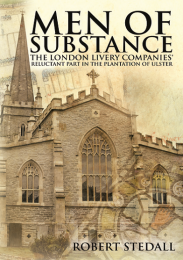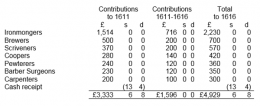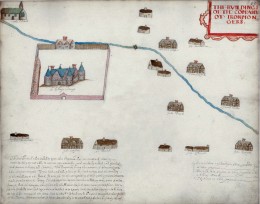The Ironmongers’ Company’s initial period in Ireland
Next » « PreviousRobert Stedall, a Past Master of the Ironmongers’ Company, explores the Company’s initial period in Ulster and the work of its first agent, George Canning.
When efforts to establish the plantation in Londonderry were begun, the Ironmongers’ Company claimed that it did not have the means to participate. It was the least wealthy of the twelve Great Companies. Although the King was insistent, about half the members remained conveniently away from town. Pressure to assess members was applied, but the Company had to augment their contributions by borrowing. Although the first levy was paid, the second proved more difficult, and the third had to be met out of the its common stock. Yet, in February 1611, it confirmed that, with support from its associated Minor Companies, it would accept land in Ulster. Contributions were as follows:
On 17 December 1613, the Ironmongers drew an area of 19,450 acres, on the Bann river upstream from Coleraine. Being in several parcels, separated by church and native freeholds, it was indefensible. With its fragmented lay out, consideration was given to dividing it among each of the associated Companies, but this was dismissed in view of the difficulty in providing security. With the Ironmongers left in sole charge, it was named the Manor of Lizard. It was uncharted territory, and Simon Kingsland was commissioned to provide a map, which he completed quickly, but inaccurately.
The Company’s particularly good early records are supported by the letters of George Canning, the first Agent. The Company was lucky in its choice. His brother William was to become Master in 1617. They were great-great-grandsons of Sir Thomas Canninge, Lord Mayor in 1456. As the sixth son, George needed to establish himself and applied for the role at a salary of £100 per annum. He was ‘a country gentleman of the type most needed to make the Plantation a success’. As most agents only sought a quick profit, he was a rarity. On arrival in 1614, he received precise instructions with regard to ‘fencing of lands, establishing boundaries, letting land, collecting rents, and keeping accounts’. Having arrived with several bricklayers and carpenters, he had soon repaired some Irish cabins to provide shelter.
Canning chose to build his settlement at Agivey on the Aghadowey River, up which barges could deliver materials from the Bann. The land was excellent and local clay was used to make bricks, but good stone was in short supply. He balanced quality with economy, turning to Coleraine, for lime, timber, slate, limestone and lath, but poor winter weather prevented delivery. Although nails could be delivered for £1 from London to Coleraine, it cost a further ten shillings to bring them up river past rapids on the Bann and by horse and cart to the settlement. His carpenters were soon making timber frames and he completed a brick kiln. He preferred ‘half-timber’ for house building, despite transportation difficulties, but each one needed 26 tons of sawn wood. Chimney stacks were of brick and casement windows were hung on iron hinges.
Canning was soon able to offer leases to workmen, who would undertake to expel the Irish, and, during 1615, he granted fifteen leases to settlers, conditional on them building two English-style houses and assisting in church repairs. Boundaries were to be hedged and Irish nomadic-style farming was prohibited. By December 1615, leases for twenty houses were granted to English and Scots. For security he wanted settlements of at least six houses, but, although his plan had been to evict the Irish, they offered higher rentals than the settlers and were retained on short leases. Without them there would have been economic collapse. He was always cavalier. In 1616, one hundred and nineteen out of one hundred and twenty-seven under-tenants remained Irish. Yet high rentals left them ever more impoverished and seething with anger.
Canning urgently requested a delivery of arms from London to combat rebels, who continued to strip clothing from the workers and stealing their tools. The castle and bawn was of critical importance. With timber being unsuitable for the walls, he used stone on the lower levels with brick above. He waited for good bricklayers, but was a respected employer, who paid promptly. The foundations needed piling on the boggy soil. Yet, by the end of 1616, he had completed a structure with walls four feet thick and thirty-one feet high, and a circular flanker at each corner. There were no interior fittings not even stairs. He claimed it as the best house built on any of the plantations, although others had been costlier. In 1619, the Government surveyor was impressed, but was concerned that the bawn had only three sides (with the river side still unbuilt) and no flankers.
Despite his problems, Canning pronounced Agivey with its six houses as ‘a great town in this country’. With thirteen further houses built by tenants elsewhere, he considered it ‘a good plantation’. He was soon generating a surplus. In 1617, with his standing well-established, he became head lessor, negotiating for himself a lucrative 41-year tenancy. This included the castle, five houses and nine townlands. He built bridges, erected a mill and repaired the church. At last, his wife and family joined him from England. Yet finding settlers was proving difficult; they would not pay what he was asking or build to the designated standard. Meanwhile the Irish continued to offer higher rents than settlers could afford.
Nothing remains of Canning’s settlement; it was destroyed in the Great Rebellion of 1641, when the settlers were butchered. In 1635, they had been left in the lurch when the Companies’ interests were expropriated by the Crown. Although Canning escaped to Londonderry, his eldest son, Paul failed in an attempt to hold Agivey against the rebels. Canning’s second son William was killed with many others in a doomed attempt to defend Garvagh, a native castle further north. When the Cromwellians restored British control in 1649, Paul establish his own settlement there. Garvagh now became the Canning family estate, from which their later title takes its name. Although Agivey was returned to the Ironmongers, it was never rebuilt.
 Robert Stedall is the author of MEN OF SUBSTANCE: The London Livery Companies’ Reluctant Part in the Plantation of Ulster recently published by Austin Macauley Publishers Ltd
Robert Stedall is the author of MEN OF SUBSTANCE: The London Livery Companies’ Reluctant Part in the Plantation of Ulster recently published by Austin Macauley Publishers Ltd
7 thoughts on “The Ironmongers’ Company’s initial period in Ireland”
Leave a Reply
You must be logged in to post a comment.


Fine brief historical sketch!
Thank you James. Are you related to George by any chance?
Yes, Philippa. I am one of a number of descendants of George. Sorting them out is a lengthy process!
George Canning, one of eight sons of Richard Canning of Foxcote, sold his estate at Barton-on-the-Heath, Warwickshire, in order to take on the lease of the Ironmongers’ estate in Co. Londonderry. One of his brothers died in India, and another in Constantinople.
James, I was away from home last week and I am not sure if my i-phone message got through. I have discussed quite a bit with Spencer Garvagh, who is Junior Warden of the Ironmongers this year. The book also contains a very abbreviated family tree of the key members of the Canning family. Thank you for your comments. Robert
Thanks, Robert. Spencer Garvagh’s mother took a keen interest in the matter and was very helpful to me years ago. And what fun that Spencer is a Junior Warden this year. I look forward to reading your book. James
I am related to Nathaniel Carrington who according to the records:
“Nathaniel Carrington, an English tenant farmer, leased in 1615 two balliboes,
Tawnymore (Tammeymore) and Cah, which were part of Lizard Plantation,
that portion of Londonderry, Ireland, set aside for settlement by the
Ironmongers’ Guild of London, Ironmongers’ Papers, guildhall Library,
London, MS. 17, 278/1, f. 108a.)”
Can you tell me anything else related to the properties or where he may be buried? I believe Cah is NE of Aghadowey Forest and West of A29. I located a Tawnymore, it is located in Co, Tyrone – don’t think that is the correct place. He may have had son Roland Carrington. Many thanks for any help you can give – Ted Carrington
Thank you for getting in touch and for your question Ted. I have passed it on to the enquiry team at London Metropolitan Archives as it concerns livery comapny records; they will reply separately. The contact address is ask.lma@cityoflondon.gov.uk in case you have any follow up queries.